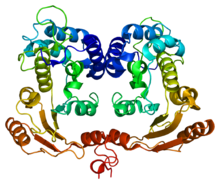NAD+ glycohydrolase
| NAD+ glycohydrolase | |||||||||
|---|---|---|---|---|---|---|---|---|---|
 | |||||||||
| Identifiers | |||||||||
| EC no. | 3.2.2.5 | ||||||||
| CAS no. | 9032-65-9 | ||||||||
| Databases | |||||||||
| IntEnz | IntEnz view | ||||||||
| BRENDA | BRENDA entry | ||||||||
| ExPASy | NiceZyme view | ||||||||
| KEGG | KEGG entry | ||||||||
| MetaCyc | metabolic pathway | ||||||||
| PRIAM | profile | ||||||||
| PDB structures | RCSB PDB PDBe PDBsum | ||||||||
| Gene Ontology | AmiGO / QuickGO | ||||||||
| |||||||||
In enzymology, a NAD+ glycohydrolase (EC 3.2.2.5) is an enzyme that catalyzes the chemical reaction
- NAD+ + H2O ADP-ribose + nicotinamide
Thus, the two substrates of this enzyme are NAD+ and H2O, whereas its two products are ADP-ribose and nicotinamide. Unlike ADP-ribosyl cyclase/cyclic ADP-ribose hydrolase (EC 3.2.2.6), which catalyzes the same reaction, this reaction does not proceed through a cyclic ADP-ribose.[1][2]
This enzyme participates in nicotinate and nicotinamide metabolism and calcium signaling pathway. Calcium metabolism involves the regulation of the levels of calcium in the body. The role this calcium plays also includes providing enough calcium for bone mineralization. It serves as the basis for the structure and rigidity of bones. Calcium metabolism can lead to a variety of diseases which can involve renal function. High concentrations of calcium can lead to cell death or apoptosis.
Nomenclature[edit]
This enzyme belongs to the family of hydrolases, specifically those glycosylases that hydrolyse N-glycosyl compounds. The systematic name of this enzyme class is NAD+ glycohydrolase. Other names in common use include
- NAD+ nucleosidase,
- NADase,
- DPNase,
- DPN hydrolase,
- NAD hydrolase,
- diphosphopyridine nucleosidase,
- nicotinamide adenine dinucleotide nucleosidase,
- NAD glycohydrolase,
- NAD nucleosidase, and
- nicotinamide adenine dinucleotide glycohydrolase.
Immunoregulation[edit]
NADase is important to regulating adaptive immunity as T cells contain enzymes such as CD38 and SARM1 that consumes NAD+.[3]
CD38[edit]
CD38 is an enzyme that triggers inflammatory responses and type II CD38 contains an ecto-NADase or extracellular NADase, whereas type II CD38 contains an intracellular cADPR.[4] CD38 consumes NAD, which can produce second messengers that help regulate immune activity.[5] Cells that are programmed for cell death or apoptosis releases NAD+, and type II CD38 help recycle the extracellular NAD+ released from apoptosis, where both products of NADase, ADP-ribose and nicotinamide, can be used to resynthesize NAD+ via the NAD+ synthesis pathway.[4] ADP-ribose must be converted to adenosine in order to enter the NAD+ synthesis pathway, where ADP-ribose first gets converted to AMP and then AMP gets converted to adenosine via non-classical adenosine generational pathway.[4] The other product nicotinamide is membrane permeable, which allows the molecule to reenter the NAD synthesis pathway more easily.[4] CD38 NADase is also found in tissues and cells other than T cells, and CD38 is the one of the main form of NADase activity in mammals.[5]
SARM1[edit]
SARM1 is a Toll-like receptor protein and also functions as a intracellular NADase.[3] Under normal circumstances NADase activity are inhibited in the presence of NAD+, where NAD+ binds to armadillo/heat motifs (ARMs), which inhibits the dimerization of the toll-like receptor domain that activates the NADase activity.[3] If there are damages to the binding site of NAD+ or disruption that prevents the interaction between ARMs and the toll-like receptor domain, NADase activity will be turned on at a constitutive level.[3] As a result SARM1 will have higher consumption of NAD+ and produce NADase products (ADP-ribose and nicotinamide) rather than the production of cADPR from ADP-ribosyl cyclase.[3]
References[edit]
- ^ "ENZYME - 3.2.2.5 NAD(+) glycohydrolase". enzyme.expasy.org. Retrieved 2022-07-11.
- ^ "ENZYME - 3.2.2.6 ADP-ribosyl cyclase/cyclic ADP-ribose hydrolase". enzyme.expasy.org. Retrieved 2022-07-11.
- ^ a b c d e Fang J, Chen W, Hou P, Liu Z, Zuo M, Liu S, et al. (May 2023). "NAD+ metabolism-based immunoregulation and therapeutic potential". Cell & Bioscience. 13 (1): 81. doi:10.1186/s13578-023-01031-5. PMC 10171153. PMID 37165408.
- ^ a b c d Lee HC, Deng QW, Zhao YJ (January 2022). "The calcium signaling enzyme CD38 - a paradigm for membrane topology defining distinct protein functions". Cell Calcium. 101: 102514. doi:10.1016/j.ceca.2021.102514. PMID 34896700.
- ^ a b Chini EN (2009). "CD38 as a regulator of cellular NAD: a novel potential pharmacological target for metabolic conditions". Current Pharmaceutical Design. 15 (1): 57–63. doi:10.2174/138161209787185788. PMC 2883294. PMID 19149603.
Further reading[edit]
- Putney JW (2019). "Calcium Metabolism". Access Science. doi:10.1036/1097-8542.103100.
- Hofmann EC, Rapoport S (October 1955). "[DPN- and TPN-specific nucleosidases in erythrocytes]". Biochimica et Biophysica Acta. 18 (2): 296. doi:10.1016/0006-3002(55)90076-7. PMID 13276383.
- Nakazawa K, Ueda K, Honjo T, Yoshihara K, Nishizuka Y, Hayaishi O (July 1968). "Nicotinamide adenine dinucleotide glycohydrolases and poly adenosine diphosphate ribose synthesis in rat liver". Biochemical and Biophysical Research Communications. 32 (2): 143–149. doi:10.1016/0006-291X(68)90360-4. PMID 5672131.
- Ueda K, Fukushima M, Okayama H, Hayaishi O (October 1975). "Nicotinamide adenine dinucleotide glycohydrolase from rat liver nuclei. Isolation and characterization of a new enzyme". The Journal of Biological Chemistry. 250 (19): 7541–7546. doi:10.1016/S0021-9258(19)40852-1. PMID 240831.
- Yamamoto-Katayama S, Ariyoshi M, Ishihara K, Hirano T, Jingami H, Morikawa K (February 2002). "Crystallographic studies on human BST-1/CD157 with ADP-ribosyl cyclase and NAD glycohydrolase activities". Journal of Molecular Biology. 316 (3): 711–723. doi:10.1006/jmbi.2001.5386. PMID 11866528.
- Mosca M, Bernardor J, Lemoine S, Bertholet-Thomas A, Bacchetta J (February 2021). "Rare diseases of phosphate and calcium metabolism: Crossing glances between nephrology and endocrinology". Annales d'Endocrinologie. 82 (1): 30–35. doi:10.1016/j.ando.2020.12.005. PMID 33316222. S2CID 229174185.

